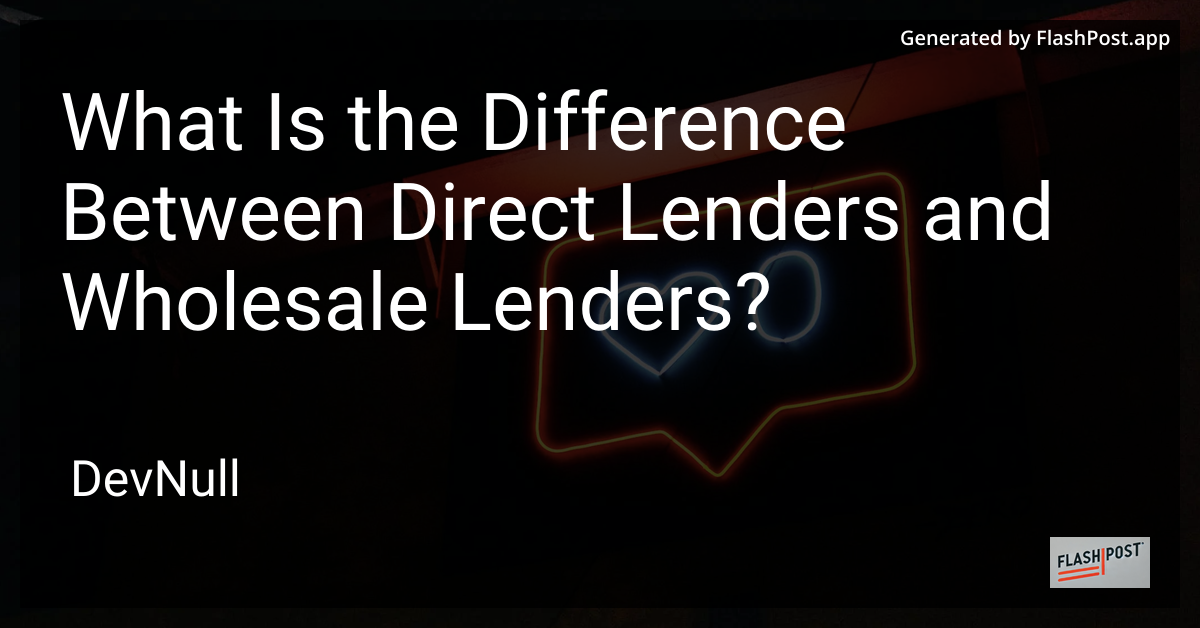

What Is the Difference Between Direct Lenders and Wholesale Lenders?
When navigating the complex world of mortgages, it’s essential to understand the different types of lenders available. Each type comes with its specific advantages, disadvantages, and relevant scenarios for use. Two common types often discussed are direct lenders and wholesale lenders. This article will dissect these categories to help you make informed financial decisions.
What is a Direct Lender?
Direct lenders are institutions or individuals that provide loans directly to the borrower without any intermediaries involved. They can be banks, credit unions, or other financial entities that handle the entire loan cycle—from application to funding—directly with the borrower.
Advantages of Direct Lenders
- Simplified Process: The process tends to be more direct since it involves only one entity, reducing potential communication issues.
- Faster Approvals: Direct lenders may offer quicker loan approval times due to direct communication and decision-making.
- Personalized Service: Borrowers can build a direct relationship with the lender, potentially easing future transactions.
Disadvantages of Direct Lenders
- Limited Options: Borrowers may only access the financial products and interest rates offered by the specific lender.
- Potentially Higher Costs: Due to the absence of competitive pricing that exists in broader marketplaces, borrowers might miss out on better deals.
Understanding Wholesale Lenders
Wholesale lenders do not deal directly with borrowers. Instead, they offer loans through third parties such as mortgage brokers or banks. These intermediaries help borrowers find the best loan products.
Advantages of Wholesale Lenders
- Access to Multiple Products: Mortgage brokers can compare multiple loan products from different wholesale lenders, potentially finding better rates and terms.
- Competitive Rates: Due to access to a wide array of lenders, borrowers may obtain more competitive rates through wholesale channels.
- Tailored Offerings: Brokers can match borrowers with lenders that are specifically suited to their financial situation.
Disadvantages of Wholesale Lenders
- Additional Fees: Borrowers may incur additional fees for the broker’s services, adding to overall loan costs.
- Impersonal Service: With multiple parties involved, the process may feel less personal and more complex.
How to Choose Between Direct and Wholesale Lenders
Selecting between a direct and wholesale lender largely depends on your personal circumstances and financial goals. Consider factors such as:
- Interest Rates: Are you seeking the most competitive rate? Understanding factors influencing mortgage rates can help in making an informed choice.
- Loan Complexity: For customized loan solutions, working with a knowledgeable broker might be beneficial.
- Fees and Penalties: It’s crucial to understand all associated costs, including potential mortgage penalties in Idaho.
- Ease of Calculation: Before meeting lenders, using a financial calculator for mortgage payments can provide clarity on what to expect monthly.
Conclusion
Deciding between a direct and wholesale lender involves weighing the benefits and costs associated with each. Whether you value direct interaction and simplified processes, or competitive rates and product variety, understanding these differences aids in securing the mortgage that best fits your needs. With the right knowledge and preparation, you can navigate the mortgage market effectively and confidently.
